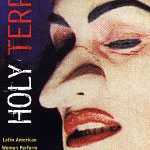Holy Terrors: The Book
Holy Terrors: Latin American Women Perform
Edited by Diana Taylor and Roselyn Costantino
Durham: Duke University Press, 2004
Holy Terrors, the book, brings together a divergent group of women artists involved in some of the most important aesthetic and political movements of Latin America. In one sense, these women don't have a lot in common either ethnically or artistically. Diana Raznovich (1945), a feminist playwright and cartoonist from Argentina, descended from Russian Jews who fled the pogroms at the turn of the 19th century and boarded the wrong boat (they thought they were going to the United States). Griselda Gambaro (1928), Argentina's most widely recognized playwright, is of Italian origin. Denise Stoklos (1950), author, director, and Brazil's most important solo performer, comes from the south of Brazil, and is of Ukrainian extraction. Diamela Eltit, born in Santiago, Chile (1949), has a Palestinian grandfather. Astrid Hadad (1957), performer, singer, director, and manager of her show, born in the southern Mexican state of Quintana Roo, is of Lebanese heritage. Jesusa Rodríguez (1955), director, actor, playwright, scenographer, entrepreneur, and feminist activist, is of Mexican indigenous and European ancestry. Sabina Berman (1955), playwright, director, poet, novelist, and film scriptwriter), is of Polish Jewish extraction. Petrona de la Cruz Cruz and Isabel Juárez Espinosa, co-founders of the FOMMA in Chiapas, Mexico, both born in the 1960s, are Tzotzil Mayan and Tzeltal Mayan, respectively. Teatro La Máscara (the Theatre of the Mask), a woman's collective from Cali, Colombia, which started in the early 1970s, includes women of diverse ethnic origins. Teresa Ralli, a founding actor, director, and writer of Peru's foremost theatre collective, Grupo Cultural Yuyachkani, is a Limeña of mixed ethnic origin. Teresa Hernández, from Puerto Rico, is a fair-skinned mix of African, indigenous, and Spanish ancestry that characterizes the mestizaje of the island. The same is true for Tania Brugera (1968), a Cuban performer who explores the long history of extermination and political repression and intervention through her work. These backgrounds attest to the racial and ethnic diversity of Latin America, and make visible a complicated history of Spanish and Portuguese colonialization, mestizaje, slavery, migration, and political turmoil that often results in displacement and exile.
The book also includes scholarly essays on many of the artists represented. Diana Taylor writes on Diana Raznovich, Robert Neustadt on Diamela Eltit, Leslie Damasceno on Denise Stoklos, Roselyn Costantino, on Astrid Hadad, Antonio Prieto Stambaugh on artists Katia Tirado and Ema Villanueva, Teresa Marerro on Petrona de la Cruz Cruz, Marlene Ramírez-Cancio, Vivian Martínez-Tabares, Jose Muñoz on Tania Bruguera. Excerpts of their essays are included for each artist. For the full text see Holy Terrors.
Begin this path: Holy Terrors: The Book
- Unimagined Communities
- Diana Raznovich (Argentina)
- Griselda Gambaro (Argentina)
- Diamela Eltit (Chile)
- Denise Stoklos (Brazil)
- Astrid Hadad (Mexico)
- Jesusa Rodríguez (Mexico)
- Katia Tirado (Mexico)
- Ema Villanueva (Mexico)
- Sabina Berman (Mexico)
- Teatro La Máscara (Colombia)
- Teresa Ralli (Perú)
- Rosa Luisa Márquez (Pueto Rico)
- Teresa Hernández (Puerto Rico)
- Tania Bruguera (Cuba)

Discussion of "Holy Terrors: The Book"
Add your voice to this discussion.
Checking your signed in status ...